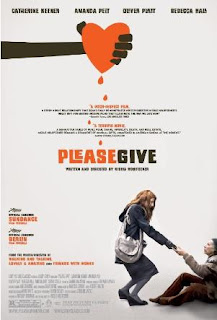Please Give
 Before Please Give, I had seen two of Nicole Holofcener's films: Walking and Talking and Lovely and Amazing (I missed Friends With Money). Frankly, I don't remember too much about them, other than that they were amiable ensemble pictures with equal parts comedy and heartbreak. Please Give, it seems to me, is much in the same vein, but with a bit of an extra bite. It's also something of a house of cards, teetering on the brink of collapse, but maintaining its structure by the end.
Before Please Give, I had seen two of Nicole Holofcener's films: Walking and Talking and Lovely and Amazing (I missed Friends With Money). Frankly, I don't remember too much about them, other than that they were amiable ensemble pictures with equal parts comedy and heartbreak. Please Give, it seems to me, is much in the same vein, but with a bit of an extra bite. It's also something of a house of cards, teetering on the brink of collapse, but maintaining its structure by the end.The story concerns the residents of two adjacent apartments in New York City. In one lives a pair of married used-furniture dealers, Catherine Keener and Oliver Platt, and their acne-plagued daughter (Sarah Steele). They acquire most of their stock by buying from the estates of the recently deceased. Keener is a bleeding heart, the kind who regularly gives money to the homeless, much to her daughter's chagrin--Keener balks at spending over two hundred dollars for a pair of jeans, not when there are so many homeless on the streets. Her daughter's reply--"What does that have to do with me?"
Next door lives an old lady (Ann Guilbert, who was once Millie Helper on the old Dick Van Dyke Show), a nonagenarian who is cared for by two granddaughters. They are cast in the tradition of King Lear, as one is good and dutiful (Rebecca Hall), while the other is cold and mean (Amanda Peet). Hall, who works giving mammograms, seems to exist in a permanent state of melancholy, while Peet is a shallow harpy who obsesses over her tan and spies on her ex-boyfriend's new girlfriend. Guilbert has been imbued with many of the negative aspects of the elderly, mainly she is so direct that she openly insults people.
The neighbors are friendly, though there is a tension that exists since it has been arranged that Keener and Platt are buying the old lady's apartment after she dies. Further complications arise when Platt and Peet begin an affair, and this is the weakest part of the film, as it's never particularly clear why they do (Platt even says he doesn't know why). I hate to bring this up, but the difference in attractiveness between the two make this plot point even harder to swallow.
The characters interact, have dinner, and go about their business. Hall goes out on a date with one of her patient's grandsons (they each take their grandmothers along to drive north to see the fall foliage). Nothing much happens, but everything happens. Keener, constantly stricken with liberal guilt, tries to find a position as a volunteer, but she is so empathetic that she is forced to leave a center for the mentally retarded because she breaks down in tears of sympathy.
I liked this film because Holofcener doesn't hold back on letting her characters expose their flaws, but she also doesn't despise them, as some filmmakers do. This is not an easy accomplishment, as Peet's character is downright despicable, and Guilbert's old lady is no day at the beach. Conversely, Keener, who is outwardly sympathetic, begins to show an almost pathological inability to function when she is crippled by her guilt. At one point she is amazed that someone bought a table from her and then turned around and sold it for a higher amount, an event that seems to me to be an unremarkable occurrence in the world of used furniture.
Though I enjoyed the film, I'm not quite sure what it was trying to say. Certainly the tension between charity and selfish consumerism is large, but I didn't get any profound insight into the issue. There are those who can walk right by a beggar without giving and feel nothing, while there are those who couldn't imagine doing the same thing. Holofcener takes no sides here. I think its best not to try to fathom a motive from the director, and simply enjoy the well-written dialogue and sharp performances.


Comments
Post a Comment